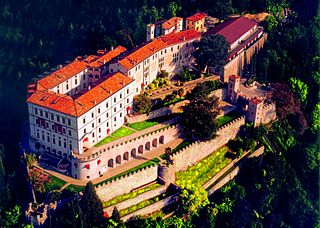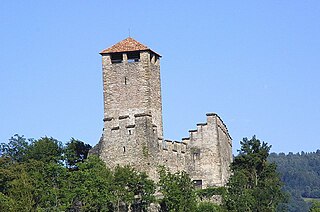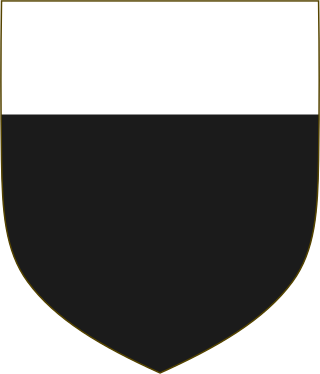Sources
- Angella, Enrica; Pietro Bongi (1993). Sulle terre dei da Camino. Pieve da Soligo: Bubola & Naibo.
Guecellone II da Camino (born Guecellone da Montanara; died 1187) was an Italian medieval noble and military leader, belonging to the Da Camino family.
The son of Gabriele I and Adeleta di Porcia, he became one of the most powerful men in the March of Treviso after the marriage to Sofia di Colfosco, who gave him in dowry large territories in the area. He was the first member of the family to use the title of Ceneda, Serravalle and Zumelle.
Around 1150 he had the castle of Camino fortified, after which it became the family's stronghold and namesake. In c. 1164 he took part in an imperial league against the commune of Treviso, alongside emperor Frederick Barbarossa. In 1183, after having been defeated, he submitted to the Trevigiani, declaring himself a citizen of the March's capital and accepting that commune's jurisdiction above his possessions.

Vittorio Veneto is a city and comune situated in the Province of Treviso, in the region of Veneto, Italy, in the northeast of Italy, between the Piave and the Livenza rivers, borders with the following municipalities:

Ezzelino III da Romano was an Italian feudal lord, a member of the Ezzelini family, in the March of Treviso. He was a close ally of the emperor Frederick II, and ruled Verona, Vicenza and Padua for almost two decades. He became infamous as a cruel tyrant, and was, in fact, the most "notorious" of the "early tyrants".

Treviso is a city and comune (municipality) in the Veneto region of northern Italy. It is the capital of the province of Treviso and the municipality had 84,669 inhabitants in September 2017. Some 3,000 live within the Venetian walls or in the historical and monumental center.

Casier is a town and comune in the province of Treviso, Veneto region, in north-eastern Italy. The commune has its seat in Dosson di Casier, and includes the localities of Frescada (partially), Le Grazie (partially), La Sicilia, Cà Matte.
Farra di Soligo is a comune (municipality) in the Province of Treviso in the Italian region Veneto, located about 50 kilometres northwest of Venice and about 25 km (16 mi) northwest of Treviso and borders the following municipalities: Follina, Miane, Moriago della Battaglia, Pieve di Soligo, Sernaglia della Battaglia, Valdobbiadene, Vidor.

Portobuffolé or Portobuffolè is a comune (municipality) in the province of Treviso, in the Italian region of Veneto, located about 50 kilometres (31 mi) northeast of Venice and about 30 kilometres (19 mi) northeast of Treviso on both the shores of the Livenza river.
San Zenone degli Ezzelini is a comune (municipality) in the Province of Treviso in the Italian region Veneto, located about 50 kilometres (31 mi) northwest of Venice and about 35 kilometres (22 mi) northwest of Treviso.
Cunizza da Romano was an Italian noblewoman and a member of the da Romano dynasty, one of the most prominent families in northeastern Italy, Cunizza's marriages and liaisons, most notably with troubadour Sordello da Goito, are widely documented. Cunizza also appears as a character in a number of works of literature, such as Dante Alighieri's Divine Comedy.
Alberico da Romano, called Alberico II, was an Italian condottiero, troubadour, and an alternatingly Guelph and Ghibelline statesman. He was also a patron of Occitan literature.
Gherardo III da Camino was an Italian feudal lord and military leader. He is generally considered the most outstanding member in the da Camino family.
Rizzardo IV da Camino was an Italian nobleman and military leader, a member of the da Camino family and lord of Treviso.

The da Camino were an Italian noble family whose fame is connected to the mediaeval history of the March of Treviso, a city of which they were lords for a while.

CastelBrando, former Castrum Costae, is a medieval castle situated on a dolomite limestone rock at an elevation of 370 m (1,210 ft) above sea level, overlooking the villages of Cison di Valmarino and Valmareno, Northern Italy. The name CastelBrando is due to the name Brandolini, the ancient family from Forlì, who were the Lords of the castle.

Zumelle Castle is a castle near the village of Tiago in the municipality of Borgo Valbelluna, province of Belluno, northern-eastern Italy.
Biaquino II da Camino was an Italian nobleman and military leader, a member of the da Camino family and lord of Treviso.
Tolberto III da Camino (1263–1317) was an Italian nobleman and military leader, a member of the Da Camino family.
Guecellone VII da Camino was an Italian nobleman and lord of Treviso.

Henry III, Count of Gorizia was a member of the Meinhardiner dynasty.

The Cortusi family was prominent in Padua in the 13th through 15th centuries. In contemporary documents, their surname may also appear as da Cortusiis, da Curtosiis, de Curtexis or de Cortisiis.

Gaia da Camino was an Italian noblewoman and poet hailing from Treviso, Italy. Her family was descended from the Lombards. She is mentioned briefly in Dante Alighieri's Divine Comedy.